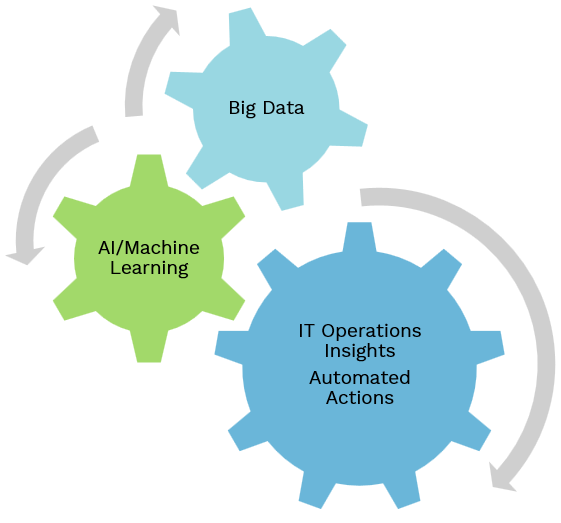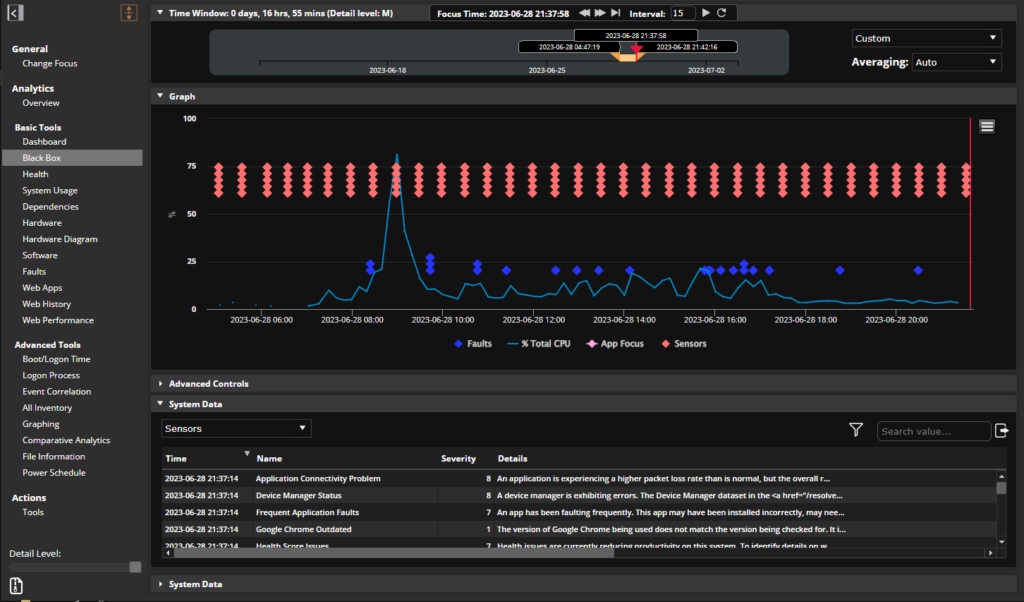What Will AIOps and Machine Learning Mean for IT?

If data is the new oil, AIOps is IT’s refinery. Short for artificial intelligence for IT operations, AIOps refers to software that combines big data and AI or machine learning to help IT manage data and find insights faster. But what does comparing data to oil mean in practical terms? And what aspects of IT operations can machine learning augment or even replace?
In a Verge video on Intel’s new smart glasses, Jerry Bautista, Intel VP and head of new devices, answers the essential question to all wearables discussions (Why?) by quoting B.K. (presumably Intel CEO, Brian Krzanich) as saying “data’s the new oil.” Bautista goes on to explain, “The point is, you have to consume that data somehow. So not only do we want to manage the data and help you compute in the data center with Intel servers and all that other stuff, we also want to be a part of presenting that data to you in a way that you can consume.”
In other words, we’ve gotten really good at collecting large amounts of data; the main challenge today is how to filter and present that data in a meaningful way. For Intel, that means creating smart glasses that contextually deliver information to the wearer—augmenting a person’s perceptions of an environment and assisting in decisions like which restaurant to eat at based on online reviews—without causing notification fatigue.
AIOps tools take a similar approach by ingesting data from multiple sources and processing it with machine learning to deliver information of greater interest to IT, such as anomalies, patterns, and predictions. Like Intel’s glasses, AIOps can help IT see their environment more clearly by streamlining what goes in front of their eyeballs.
Although it’s taken some time for machine learning to gain widespread IT acceptance, Gartner predicts that by 2019, “25% of global enterprises will have strategically implemented an AIOps platform supporting two or more major IT operations functions.”
Will your organization be part of that 25 percent?
Free solution brief: SysTrack AIOps for End-User Computing
AIOps Definition
In an interview with APMdigest, Colin Fletcher, Research Director at Gartner, defines AIOps as platforms that “utilize big data, modern machine learning and other advanced analytics technologies to directly and indirectly enhance all primary IT operations functions with proactive, personal and dynamic insight. AIOps platforms enable the concurrent use of multiple data sources, data collection methods, analytical technologies (real-time and deep) and presentation technologies.” These platforms fit into an overall event correlation and analysis (ECA) strategy, which is concerned with accelerating and automating issue resolution to reduce downtime and improve end-user experience through proactive support. ECA accomplishes this by reducing duplicate and irrelevant notifications, filtering data to find insights faster, and addressing the root cause of issues to prevent them from coming back.
Ultimately, IT tools are only as valuable as the actionable insights they produce. Today’s enterprise IT environments are like Frankenstein’s monster: patchworked, emotionally-charged, and difficult to wrangle. To work on them, IT uses a variety of monitoring and management tools to gain understanding from multiple perspectives (e.g. endpoint, network, infrastructure, application, etc.). But it is challenging to correlate events across multiple tools: duplicate alarms and events make environments noisy and the speed of support drops as IT tries to sort through a flurry of notifications and manage multiple data silos.
AIOps tools cut through the clutter and provide a unified viewpoint by ingesting and storing data from multiple sources. The richer the data streams, the better the insights will be. AIOps tools typically collect little (if any) data on their own. Rather, the scope and success of AIOps relies heavily on the quality of data coming from other monitoring tools in the environment. When implementing AIOps, it is important to consider what data your existing tools collect to determine what use cases AIOps could support.
Eventually, the goal is for these tools to become smart enough and incorporate mechanisms to be able to automatically resolve issues without human intervention. For now, AIOps mostly serves as an intelligent data filter. Whether it’s right for your IT ops team depends on if the team has the skills necessary for training the algorithms and identifying use cases, as well as if you have the time and budget to dedicate to an AIOps initiative, which can be resource-intensive.
Adopting AIOps won’t happen overnight, and it’s important to monitor the tools themselves as well as changes in end-user experience to ensure that the project is successfully addressing the needs of the broader organization.
How Will AIOps Affect End-User Experience?
AIOps is not about to render IT professionals obsolete. In fact, the technology can make IT jobs less tedious and more impactful by automating routine functions, finding patterns faster, and even highlighting patterns that IT wouldn’t have been able to discover without the help of machine learning.
Digital experience monitoring (DEM) is a technology that IT can use in conjunction with AIOps to provide visibility into the interactions between end users and technology. DEM tools collect and analyze data related to usage, system and application performance, and end-user experience.
Currently, many AIOps platforms focus on ingesting infrastructure data, which helps to ensure that services are functional, but doesn’t offer insight at the end-user level. With DEM data, AIOps tools can accelerate end-user focused IT operations tasks, augment popular use cases, and even help identify new ones, such as the following:
- Proactive support and prediction
For example, DEM data would show increasing application latency. AIOps tools that ingest that data stream could accelerate the discovery of which applications are causing latency and which user groups are affected. From there, the tool could suggest actions to resolve the issue before users are impacted and forecast whether it’s likely to happen again. - Monitoring end-user experience
DEM tools that quantify end-user experience give IT a reference for overall environmental health and a high-level indicator of changes in performance. By ingesting this data, AIOps can take this monitoring a step further and compare end-user experience data to data coming from other monitoring tools, potentially even discovering new ways that resources and services influence end-user experience. - Measuring time to detect anomalies
DEM lets IT measure the amount of time it takes for a human technician to discover a pattern by looking at metrics like time spent with a monitoring application. IT can compare this information with rates of AIOps pattern discovery to see which tasks are best suited for assistance or automation. Quantifying the speed of AIOps versus human monitoring can help IT demonstrate improvements in service quality and justify expansion of the technology using indicators like rate of anomaly detection and MTTR.
Read about how DEM can unlock end-user productivity
SysTrack AIOps Success
SysTrack, Lakeside’s workspace analytics solution, helps IT teams achieve success with DEM as well as asset optimization, event correlation and analysis, and desktop transformation. Through integrations with AIOps platforms, including IBM Operations Analytics – Predictive Insights, SysTrack provides the detailed real-time and historical endpoint data that IT operations needs to execute AIOps use cases, including proactive monitoring. SysTrack’s unique end-user experience score serves as a quantifiable measure of the impact of IT actions on end users. Ask SysTrack, Lakeside’s award-winning, NLP engine, allows IT to type or speak questions about their environment in plain English and return suggested answers for accelerated root cause analysis.
As the workspace evolves and EUC environments become more complex, IT must look for ways to keep pace with changing requirements. Augmenting IT operations with machine learning is one way for IT to discover insights faster. Equally as important will be finding a way to judge the success of these attempts and measure their impact on end users. DEM solutions can be used alongside AIOps to support the adoption of the technology and guarantee its success in the long-term.
In the Verge video I mentioned at the top, Intel says that the most exciting part of their new smart glasses isn’t the tech involved (although that’s cool, too), but what use cases developers might dream up that could change the way we view and interact with the world around us. AIOps holds similar potential; it’s up to IT to determine what’s next.
Subscribe to the Lakeside Newsletter
Receive platform tips, release updates, news and more




